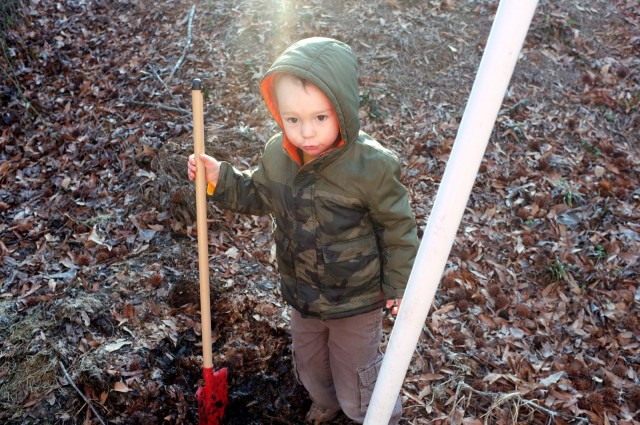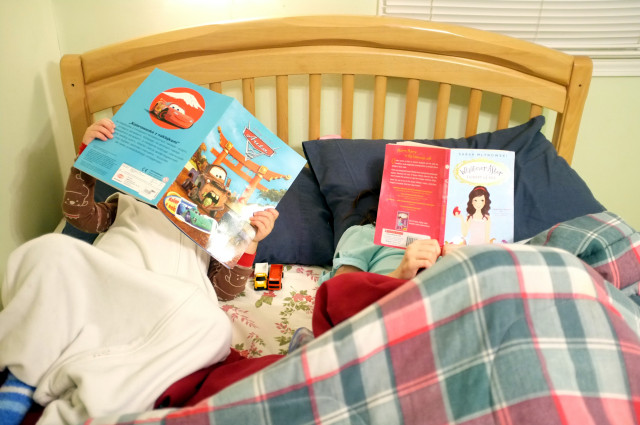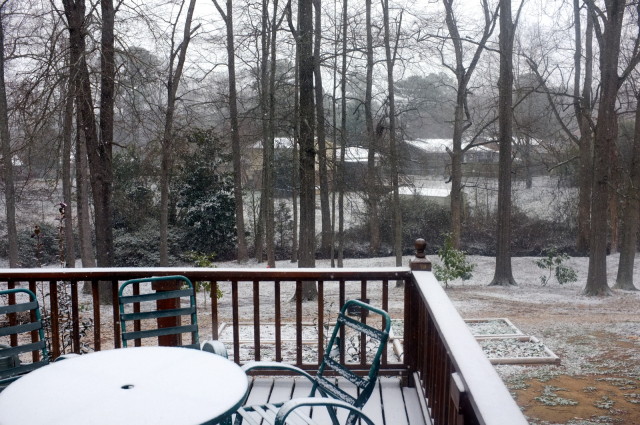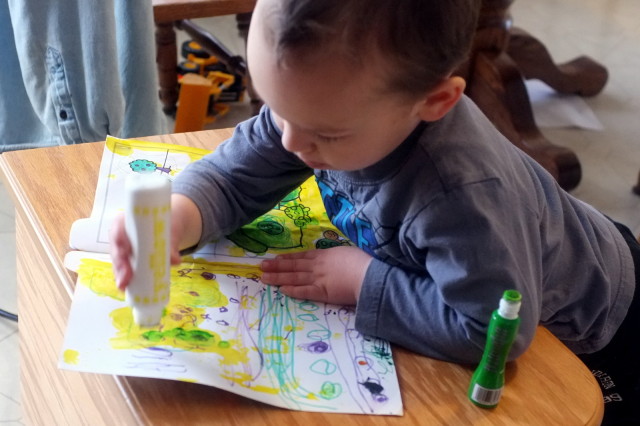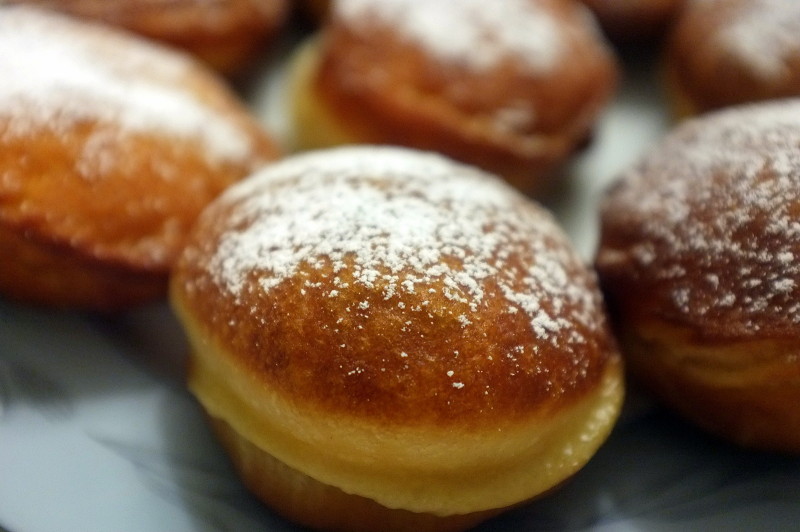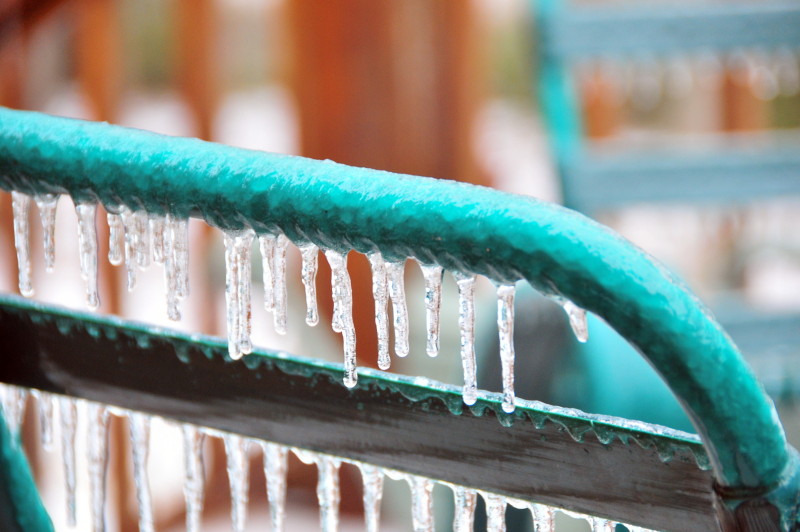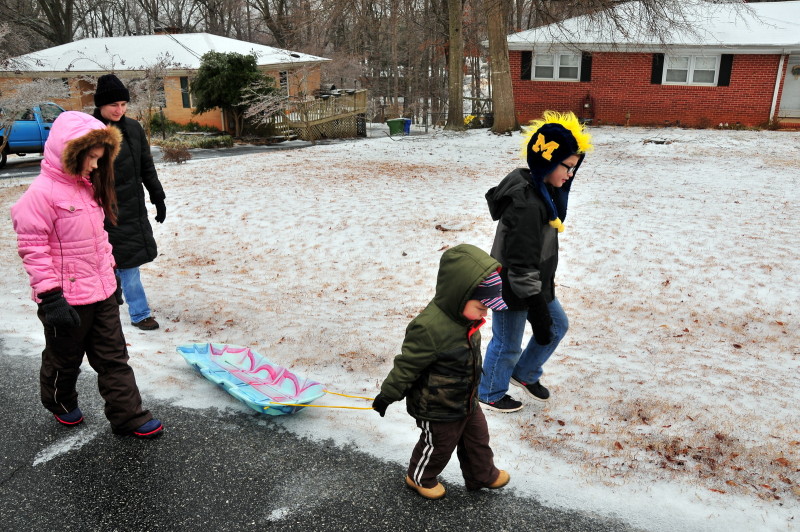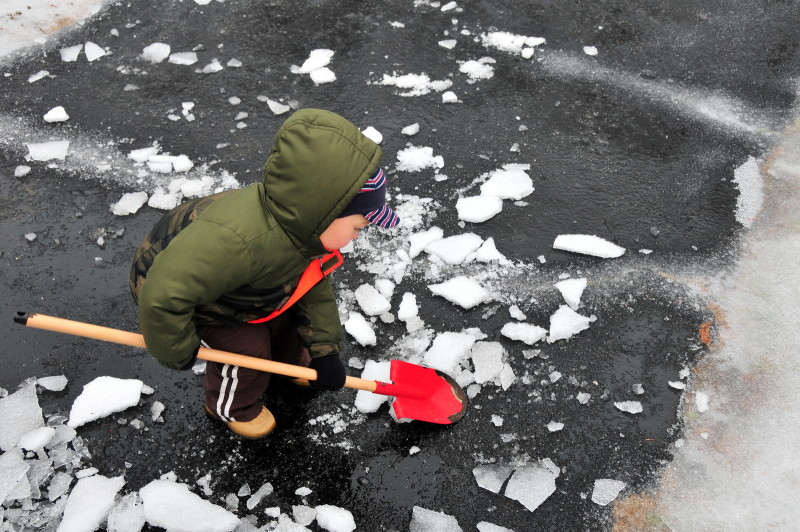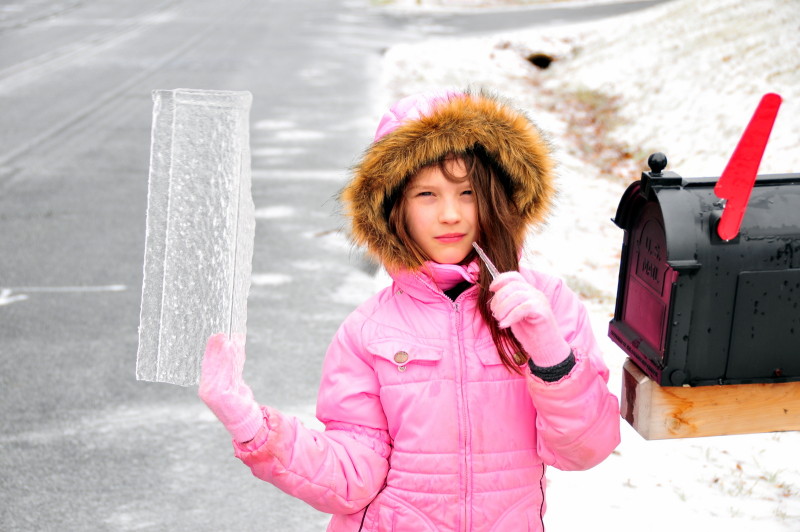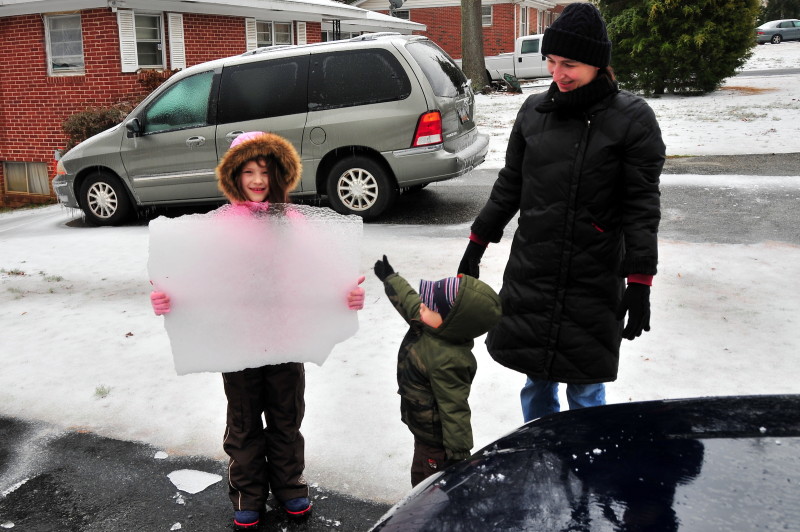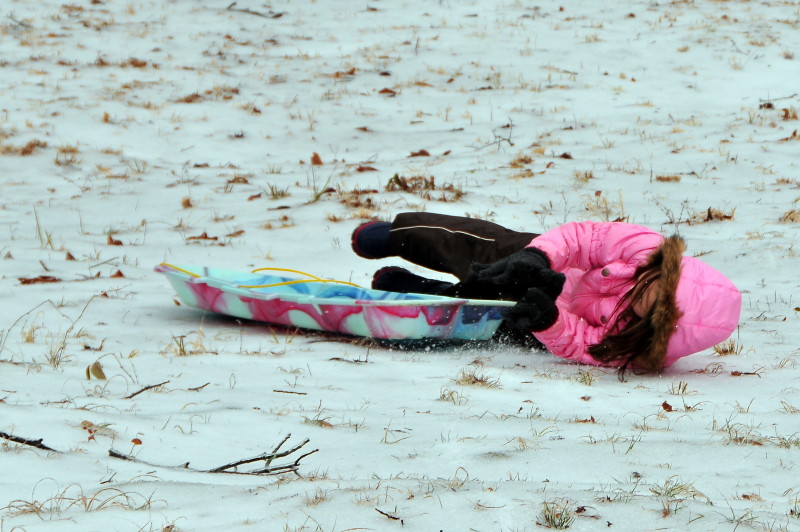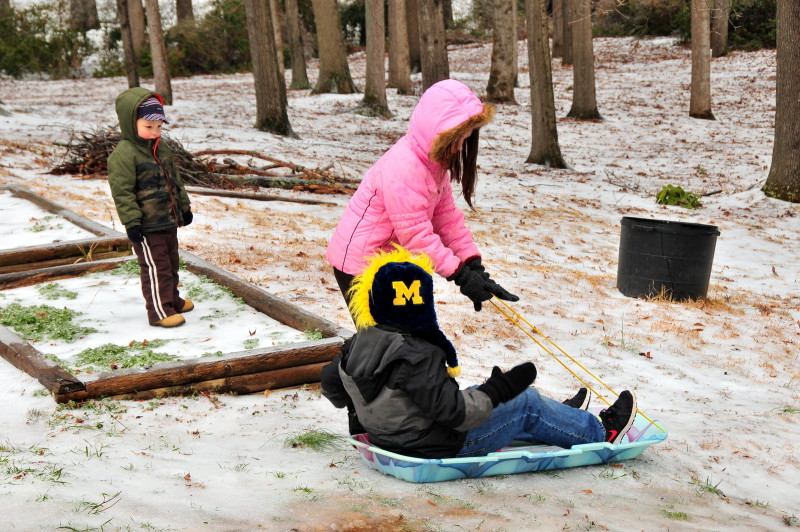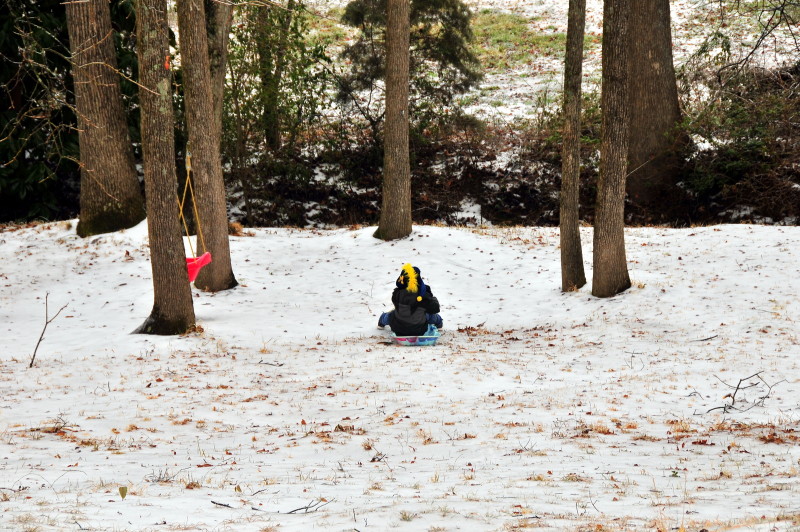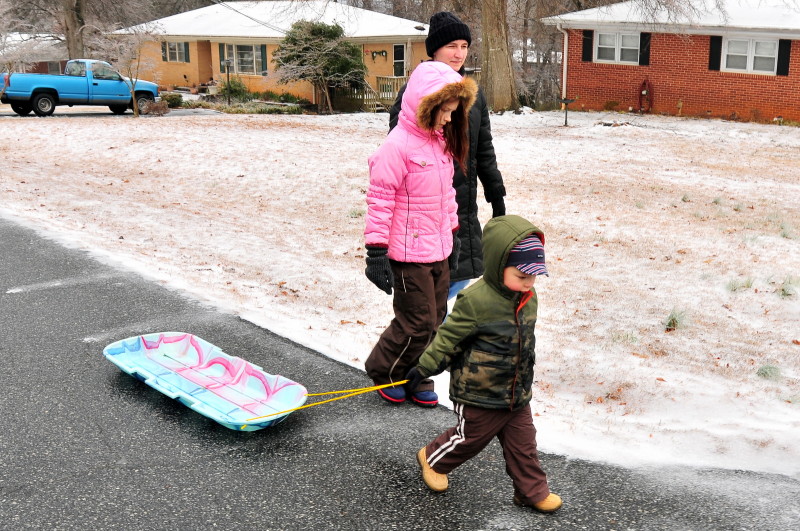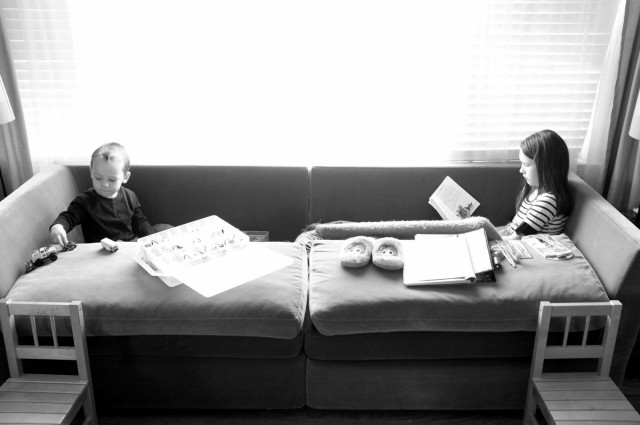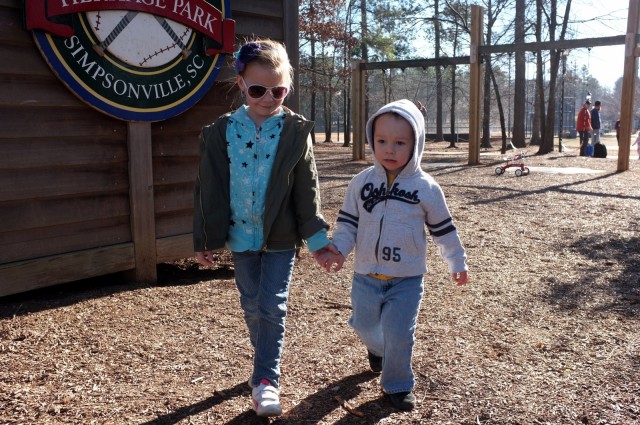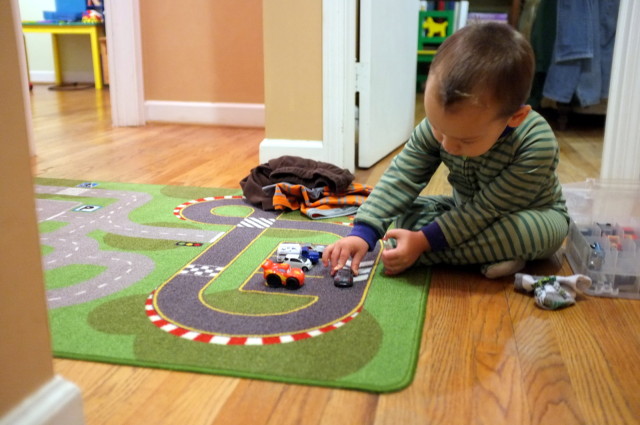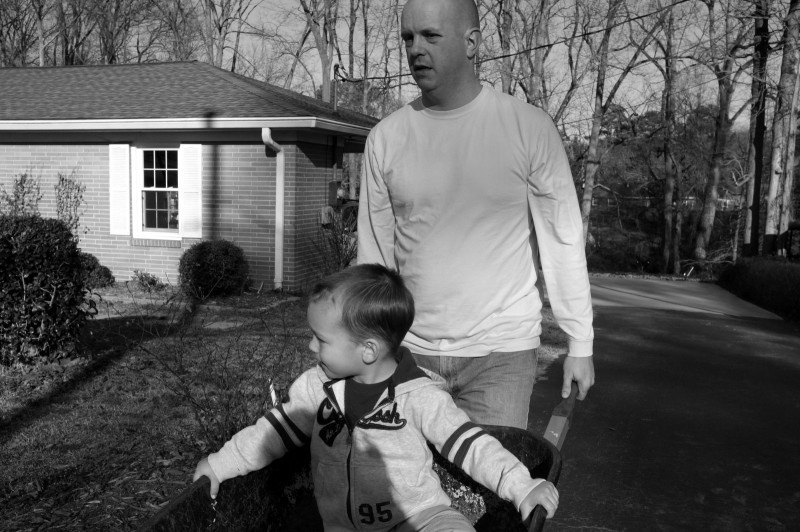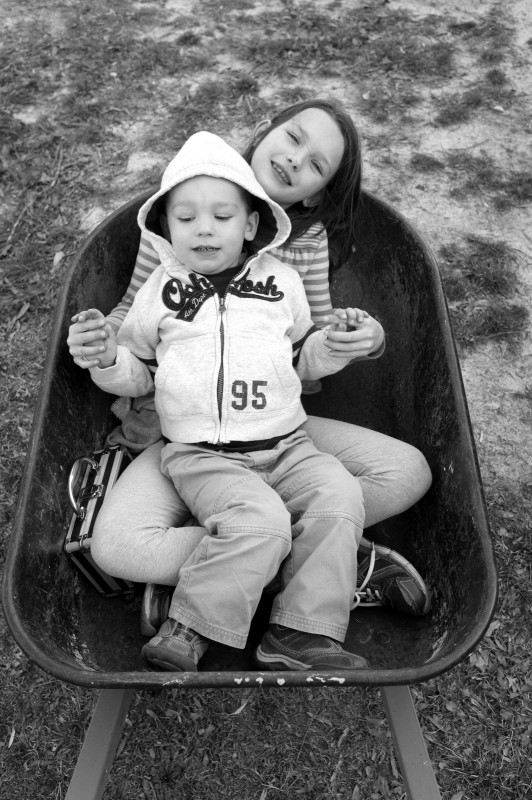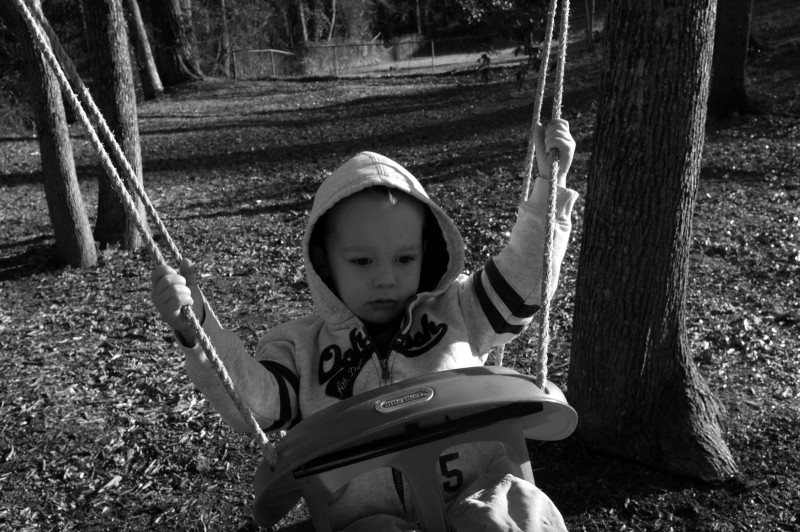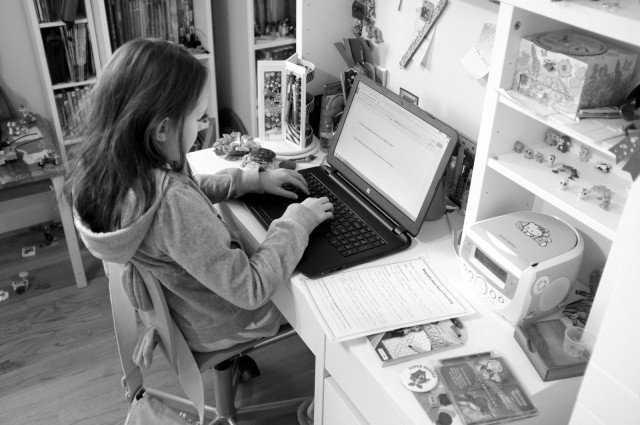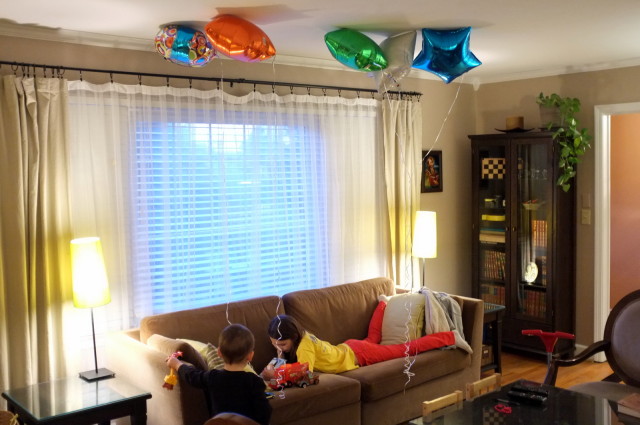Snow Man Melting
Double Snow
Tuesday we had a snow day. The Boy was so thrilled at the prospect of playing in the snow that it really didn’t matter that there was no snow to speak of. All Monday evening he was talking about getting to play in the snow, getting to make a snow man, throw snowballs, shovel snow with his backhoe.
I knew that there was little chance of snowball fights, snowmen, or much else. But I’d also known that a bigger storm was coming later in the week. A real storm. So I reassured the Boy that we would have plenty of snow to play in come Thursday.
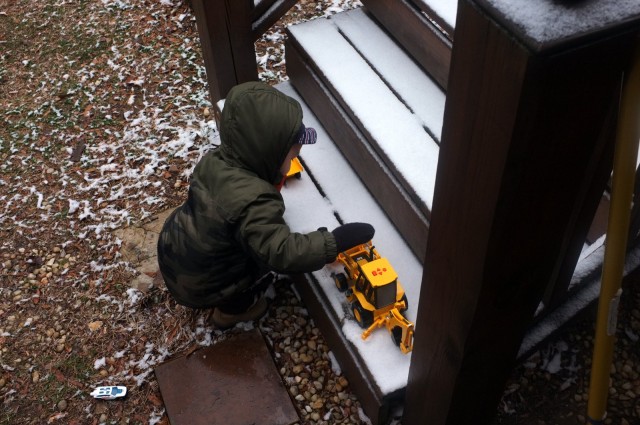
The Boy didn’t mind the small amount of snow, though. Snow is snow, and as long as it was something he could shove around with his toys, he was thrilled.
We were all excited about Wednesday’s storm, though. They kept shifting the start time, further and further back, from late afternoon to early evening, but the intensity only grew. Three to five inches eventually became a possibility up to ten inches — a real snow storm.
Wednesday during class when students asked when certain assignments were due, I kept saying things like, “If this storm is anything like they’re saying it will be, we won’t be coming back until Monday, so we’ll make it due then.”
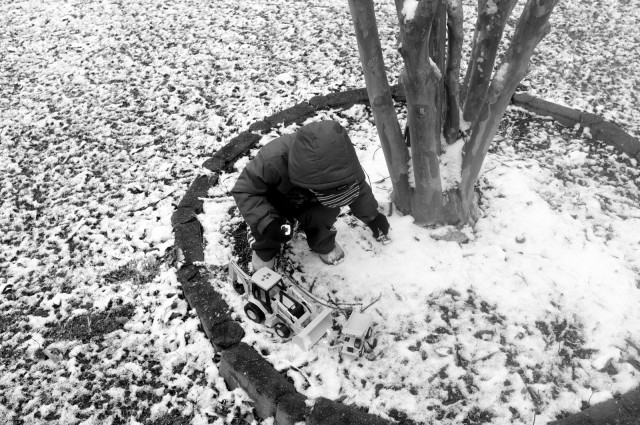
Finally the snow began, and it looked so promising, falling so thick and hard that it was possible even to capture it in a picture. I thought of the few great snow storms of my youth in southwest Virginia, where it rarely snowed but every few years would let loose a great storm that piled drifts three or more feet deep. Snow so deep that one had to pack it down before sledding was even a remote possibility. Snow that turned everything into a white blanket. Of course there’s no comparing that to the seven winters I spent in southern Poland, the winters that were the norm of K’s youth, where there was so much snow that even I got sick of it.

The governor had already declared a state of emergency, and all the reporters, after literally reporting on half an inch of snow Tuesday with giddy delight, were all probably flushed with anticipation. The school district canceled school before we’d even completed Wednesday’s schedule, and friends posted pictures on social media of virtually empty bread aisles in local supermarkets.
But when we woke up this morning, expectant, we found a repeat of Tuesday, a thin layer of slush that seemed destined to melt shortly after lunch.

Local news web sites quickly offered stories explaining what happened. “The moisture was there,” meteorologists explained, “but the temperature just popped up two degrees and that changed everything.” Our official total, as opposed to five or more inches, was 0.8 inches. Further north there were totals more like what we were promised, but nothing really that impressive. Headlines developed through the day: “National Weather Service stands by Upstate snow forecast.” It seemed everyone was disappointed on one level or another.
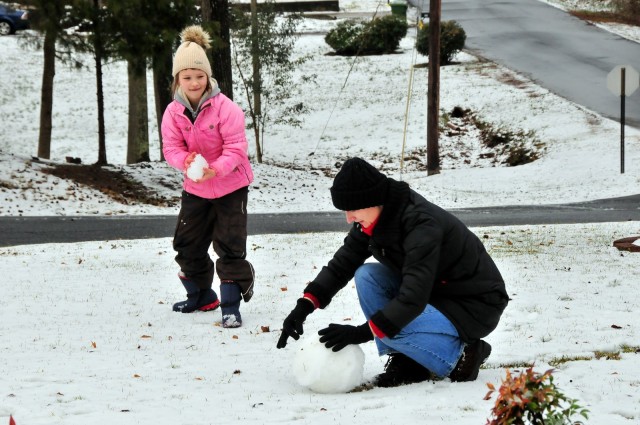
Still, we had enough slush on the ground to roll a small snowman, enough slush to get in boots and make the Girl complain, enough slush to get the Boy cold in a few minutes and whining to go inside.
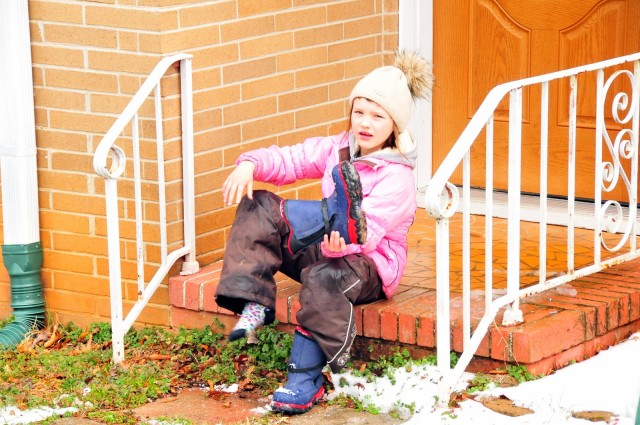
But not enough snow even to get all the ground damp.

We in the South take what we can get when it comes to snow, though. Supposedly areas of Alabama and Mississippi got close to ten inches, so perhaps by the time it got here — well, who knows. We had slush, we built a slushman, and headed in late morning knowing perfectly well that we would be going to school tomorrow.
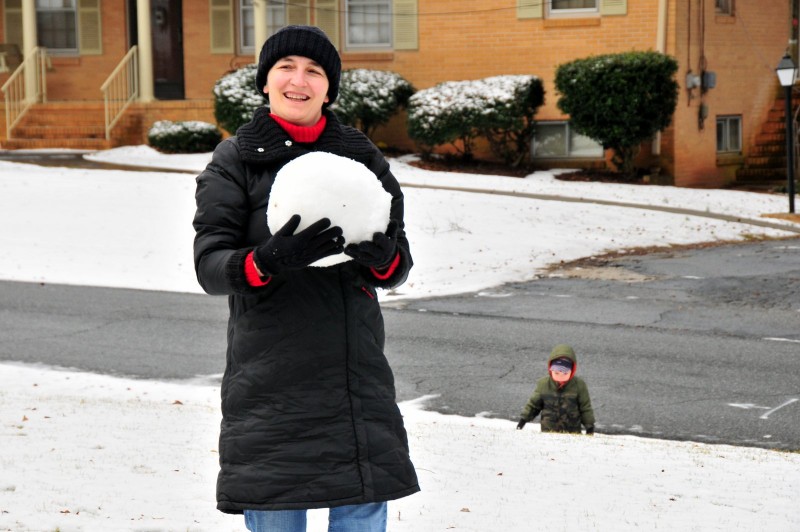
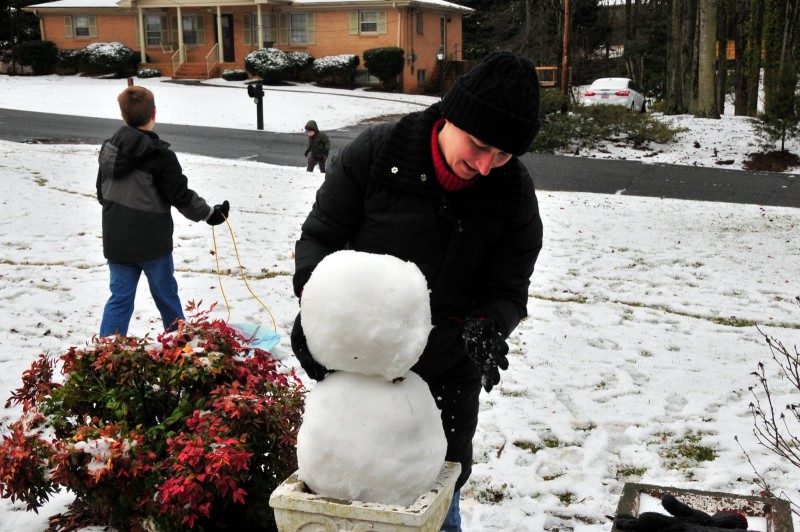
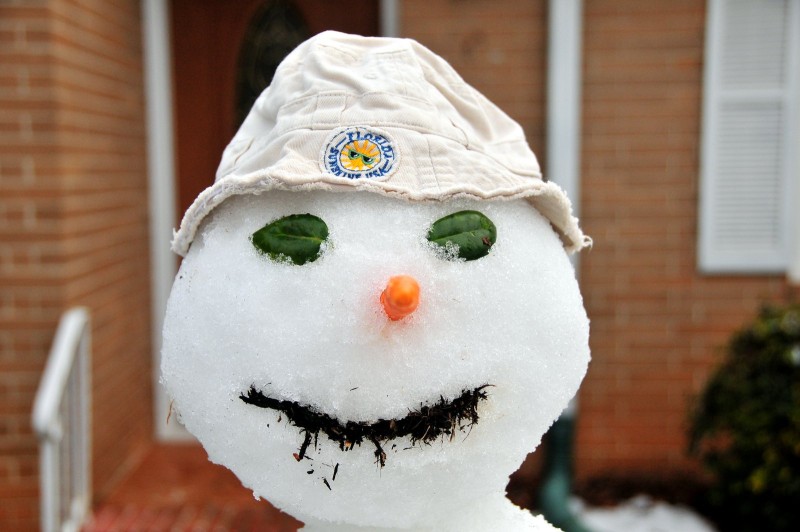

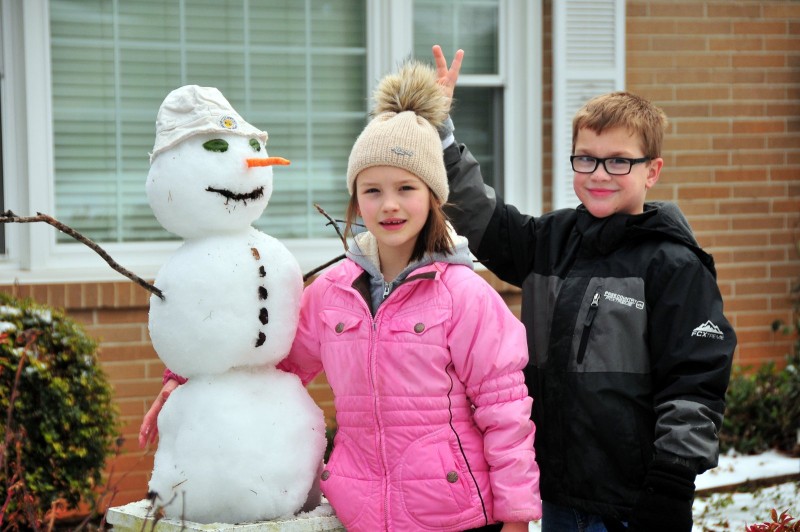
Commonality
Snow in the South
Painting
Introduction to Journalism
What I would be saying to rising eighth-graders tomorrow about my new journalism class — if I weren’t taking a sick day, that is.
This course will use the basic instructional principle of “Learn to do it by doing it.” That’s not to say there’s no direct instruction, nor is that to say that it’s a free-for-all. And it certainly doesn’t mean it will be an easy course.
This class will be responsible for creating content for the Hughes Academy web site in the form of articles, audio stories, and photographs.
- Most basically and most importantly, you will learn how to find and develop stories as well as how to write and research according to journalism industry standards. (In other words, you will not only learn what the AP stylebook is, but you’ll also have large segments of it memorized from constant reference.)
- In addition, you will learn how to take compelling photographs to accompany your stories. (In other words, you’ll learn how to take your photography skills beyond simple point-and-shoot and selfies and learn all the components that go into taking photos and how to manipulate them for the desired effect.)
- Finally, you’ll learn how to make NPR-style audio stories that incorporate on-site reporting with interesting commentary. (In other words, you’ll learn how to take 15-20 audio clips and put them together into one, strong story.)
Students interested in this class need to be highly self-driven as you will (with prior instruction) be responsible for finding your own stories to research and to write. In addition, most of the assessment will involve self-assessment with self-generated goals and rubrics (also with prior instruction and continual teacher guidance). Finally, students will have to be able to work under tight deadlines and to be the type of student that simply doesn’t give up when obstacles appear. On average, you will write at least one 500-word story per week and create at least one 4-5 minute audio story per quarter. That sounds easier than it is: the real difficulty comes from the incredibly high standards necessitated by the simple fact that all our content will end up on the Hughes web site.
What are the upsides of all this hard work? The first would be the simple pride in the fact that you are doing a job that has traditionally been reserved for adults: you will be the public, digital spokespersons for Hughes Academy, and that’s what I meant by “Learning by doing.” It’s an incredible feeling knowing that what you’re writing is for an interested audience that will make comments and give feedback, much more rewarding than just writing for a teacher. Â You’ll begin creating content for the site during the first class session, and by the time the year is done, you will have an impressive portfolio of published work that you can use for future reference. Additionally, because of the nature of this class, there is a lot of freedom during the class period. During a typical class, some students will be working together on an audio project while other students head out to interview a teacher or an administrator about this or that while still other students are editing others’ work while yet other students go to photograph subjects for their articles. In short, it’s not a “sit down and take notes” class, but it is in fact the ultimate in project-based learning: student driven, student assessed (with help of course), and student published.
It won’t be easy, but it will be fun, and you’ll finish the year with greatly improved writing skills.
Snowday 2015
With the Cat
What Blues Should Sound Like
Late Morning
Superlative
Every morning, she walks down the hall saying the same thing. Our eighth-grade school counselor’s mantra is, “It’s going to be a great day!” We teachers all smile at her and nod affirmingly or make a snide comment with a smile — “Not with this headache” or some similar thought — and move into our day without giving it another thought. While she does mean it — she certainly wishes we all have a great day — it’s also become somewhat of a running joke as well. She’ll look at what’s going on in the hallway, some kind of drama or other, raise her eyebrows, turn to the nearest teach and repeat, “It’s going to be a great day.”
Some days she’s prophetic: some days turn out really well. They have to — it’s the nature of teaching to have the bad but also the good, that which drew idealistic people into the profession to begin with. We all have visions of changing the world, one child at a time, of promoting self-confidence in this student, of helping that student discover latent talent. We know the statistics. We know some of the stories trailing behind our students. And we’re there to help. That’s the idealistic vision of teaching that we all cling to.
Yet even in the seemingly brightest days, there’s a kid who refuses to work, a boy who brings in some baggage from a hallway interaction and disrupts the class, a girl who is still stewing over some injustice, perceived or real, suffered in the previous class. It’s good, but it’s never perfect. How could it be? It seems for a perfect day, everyone involved in our classroom routines would need to be having perfect days as well, or at least extremely good days.
That’s the thought anyway, for such days are so rare that I think we teachers sometimes even forget they exist. The other days seem to crowd out everything else, and at one point or another, we teachers, each and everyone, have found ourselves standing in our classroom, loo out our window, wondering if we need to get out of the profession. We smile at each other in the hallway during these days and say things like, “I feel like today, if I’d just stayed home and bashed my head into the wall for eight hours, I’d have more to show for it.”
And then the stars align, the kids smile, and every kid in every class is, to some degree or other, productive. First period, a traditionally tough period for me, slides by without me even realizing the class period is about to end, and the kids, with their pencils scribbling during our Friday writing/workshop session, don’t realize it either. Kids who just Monday mounted a virtual mutiny in class. But today, they’re writing, conferencing with each other, focused. Working.
Second period comes, and everyone is busy, working on stories for the school web site or creating audio stories, heading out to interview this teacher or get information from that administrator. On the best days, the class feels like a newsroom must, and that’s a good thing, for next year, the course will officially be rebranded: “Journalism.”
Third period — a planning period — arrives, and with it, a call from the principal with a simple question about next year that just brings a smile to my face.
Fourth period, and the kids all work marvelously in groups, piecing together a rather complex argument in a rather long article, collaborating and learning at the same time. This is English I Honors, and I rarely have any issues with them, but some days, they’re just more productive than others. Today is such a day.
Fifth period, my most challenging, and everyone is writing, writing, writing. I’m sitting with a student, looking over his work, realizing that, out of seemingly nowhere, this kid’s writing has suddenly improved so drastically that it doesn’t even look like it could come from the same young man. Once again, I almost don’t realize that the class period is about to end, and neither do they.
Sixth period and we have a small epiphany about a passage in Lord of the Flies.
Roger gathered a handful of stones and began to throw them. Yet there was a space round Henry, perhaps six yards in diameter, into which he dare not throw. Here, invisible yet strong, was the taboo of the old life. Round the squatting child was the protection of parents and school and policemen and the law.
It’s not a real epiphany, for I’d aligned everything for the kids to “arrive” at that realization. They were set up, but sometimes my setups don’t work.
Seventh period — another planning period — and I cast a backward glance over my day and realize it’s the best day I’ve had in recent memory. Certainly the best day of this school year. Likely one of the top ten days I’ve ever had in the classroom: everyone productive, everyone cooperating, everyone working, everyone learning. I sit and analyze what happened that created such perfection. What did I do differently? How can I replicate this? Why don’t days like this more occur more frequently?
In the end, I realize once again the obvious: because so many people were involved today in creating such an amazing day, I can’t possibly hope to recreate it on my own. It’s not what I did, it’s what we did. It’s not how I can replicate it, but how we can replicate it. It’s a frustrating realization because it means that the power is both within me and out of my control. It brings to mind an analogy a colleague once made: teaching is like gardening. We prepare the soil, plant the seeds, we water the garden, and sometimes, we see the fruit, and sometimes we only hope that the seed will germinate at some later point.
But some days, like today, it seems like everything is sprouting.
A New Friend
First Confession
Congratulations to our Girl, the big girl, and for at least fifteen minutes this evening after her first confession in preparation for her first communion, a saint.
Morning Play
My Amelia Earhart Report
Amelia Earhart was born in Atchison, Kansas July 24, 1897. She was a hero to many people because she flew long distances like fly across the Atlantic Ocean.
When Amelia Earhart was a child she was the first to try new things. After the World’s Fair she and her friends tried to build a roller coaster. She was the first to try it and she got hurt. She liked to go fast and was very brave. Once in the winter it snowed. Amelia and her friends went sledding. She had to duck under a horse not to get hurt.
When she was an adult, she flew long distances alone. She was a woman and the first woman to fly across the USA and the Atlantic Ocean.
She wanted to be an independent woman. She didn’t want to marry just any man. First Sam Chapman asked to marry her and then later he asked again. Amelia said “no” twice. Then George Putnam asked to marry her. Amelia took the risk and said “yes.”
Amelia Earhart’s plane disappeared when she was trying to fly across the world on July 2, 1937. Fred Noonan was one of Amelia’s helpers. He was trying to navigate to Howland. It was a tiny strip of sand, and they couldn’t spot it. The fuel ran out, and they crashed. No one ever found her.
If I could ask Amelia Earhart a question I would ask her this “Why did you risk marrying George Putnam?”
Sunday Afternoon
Writing
The Girl is to write a research-based biographical report about Amelia Earhart. As with all homework, I’m willing (and sometimes insistent) to help her, at least to check her work. But this is a big assignment. We’ve needed to pace ourselves, so last week, we set up a schedule on Google Calendar to make sure L completed everything in a timely fashion and didn’t simply let everything pile up at the end.
She completed the book, she finished the planning, and today, it was time to begin the report.
It’s a fine line, though, between helping and doing for the Girl. As a writing teacher, I have experience in guiding students to see the problems with their writing and helping them improve it. But in the back of my mind, I say to myself, “This needs to look like a second-grader wrote it.” Should I teach her to transition between ideas within a paragraph? Should I show her how to turn her one-sentence opening, her thesis, into a full paragraph?
I’ve decided simply to guide her as minimally as possible, then ask her to read the finished product. If she feels it’s clumsy, if she comments on the short introductory paragraph, we’ll get to work fixing it.

